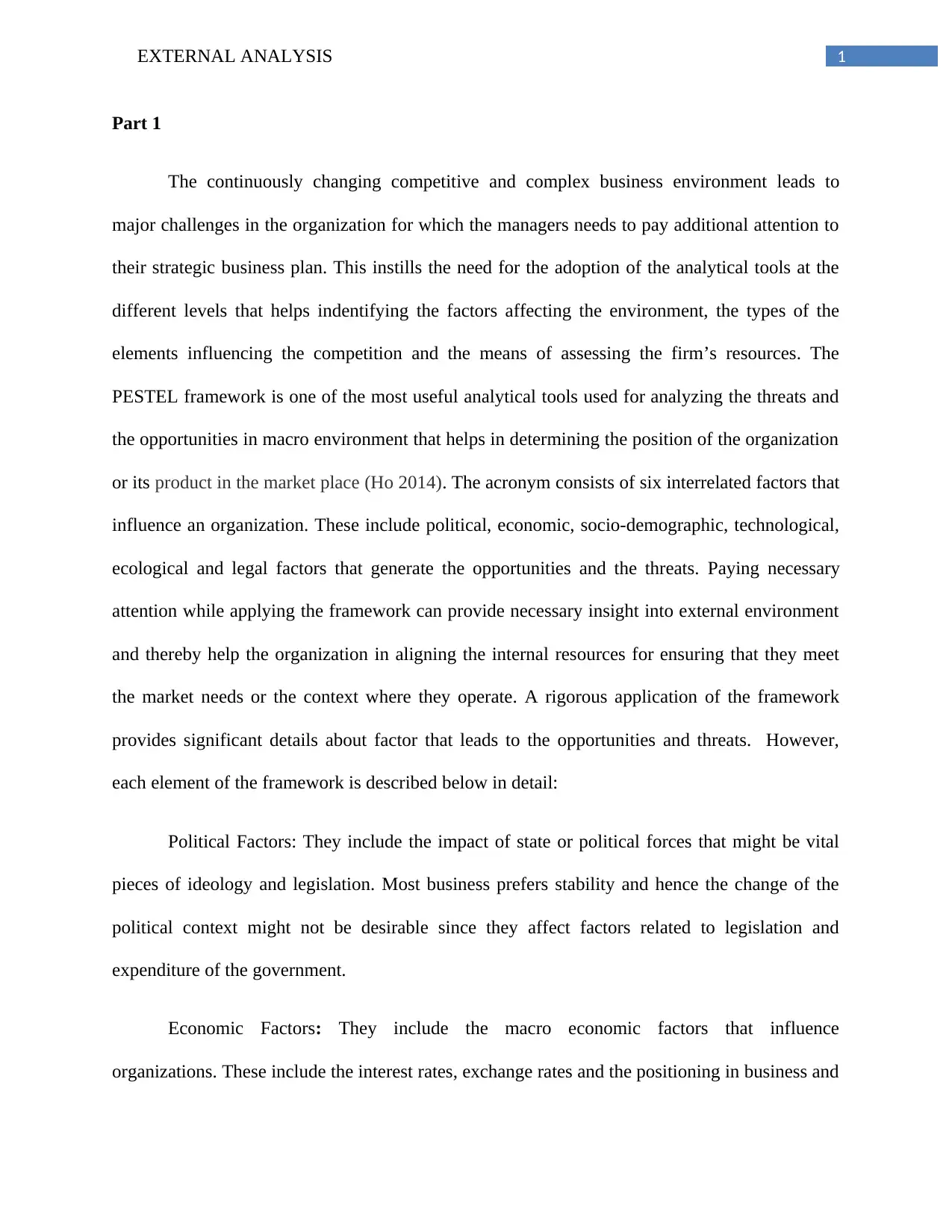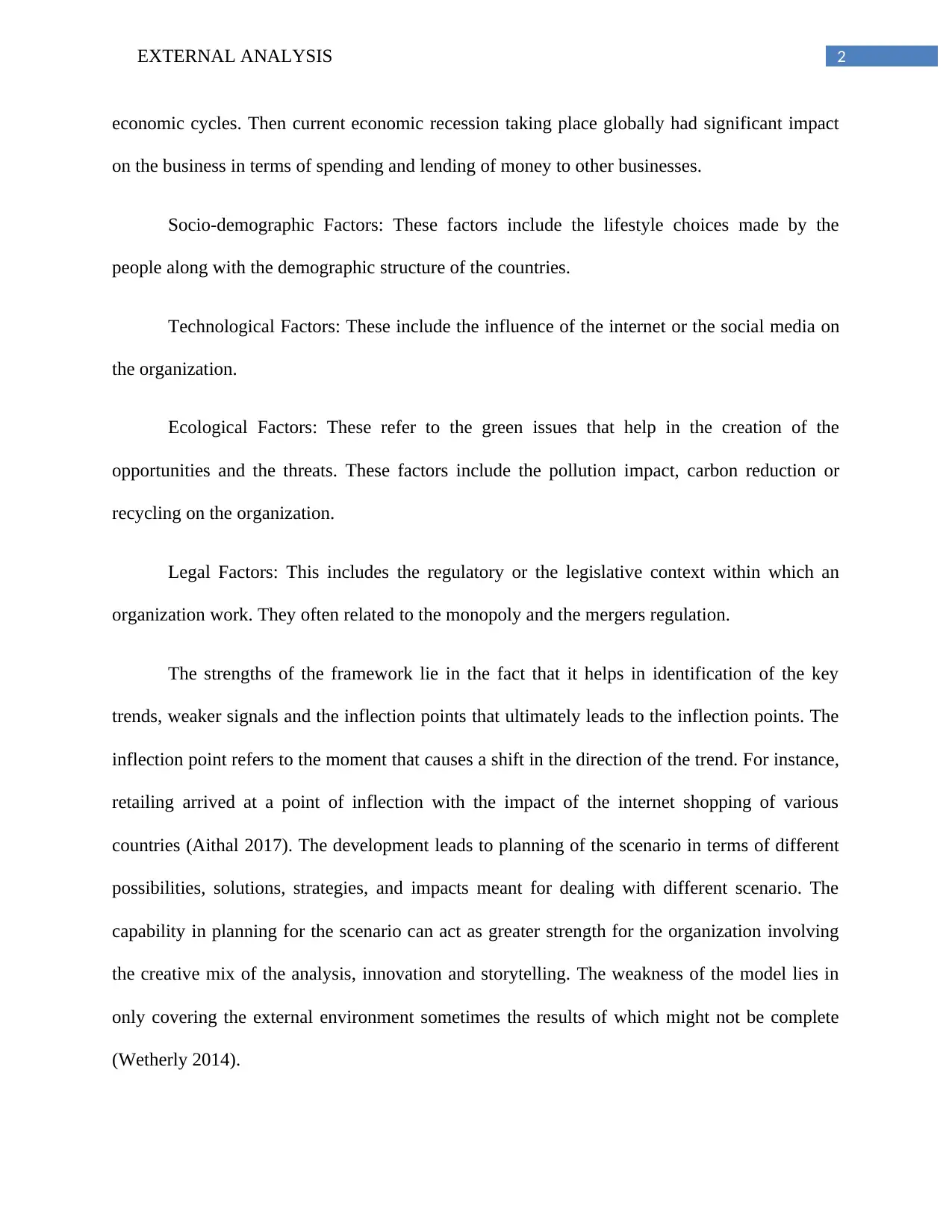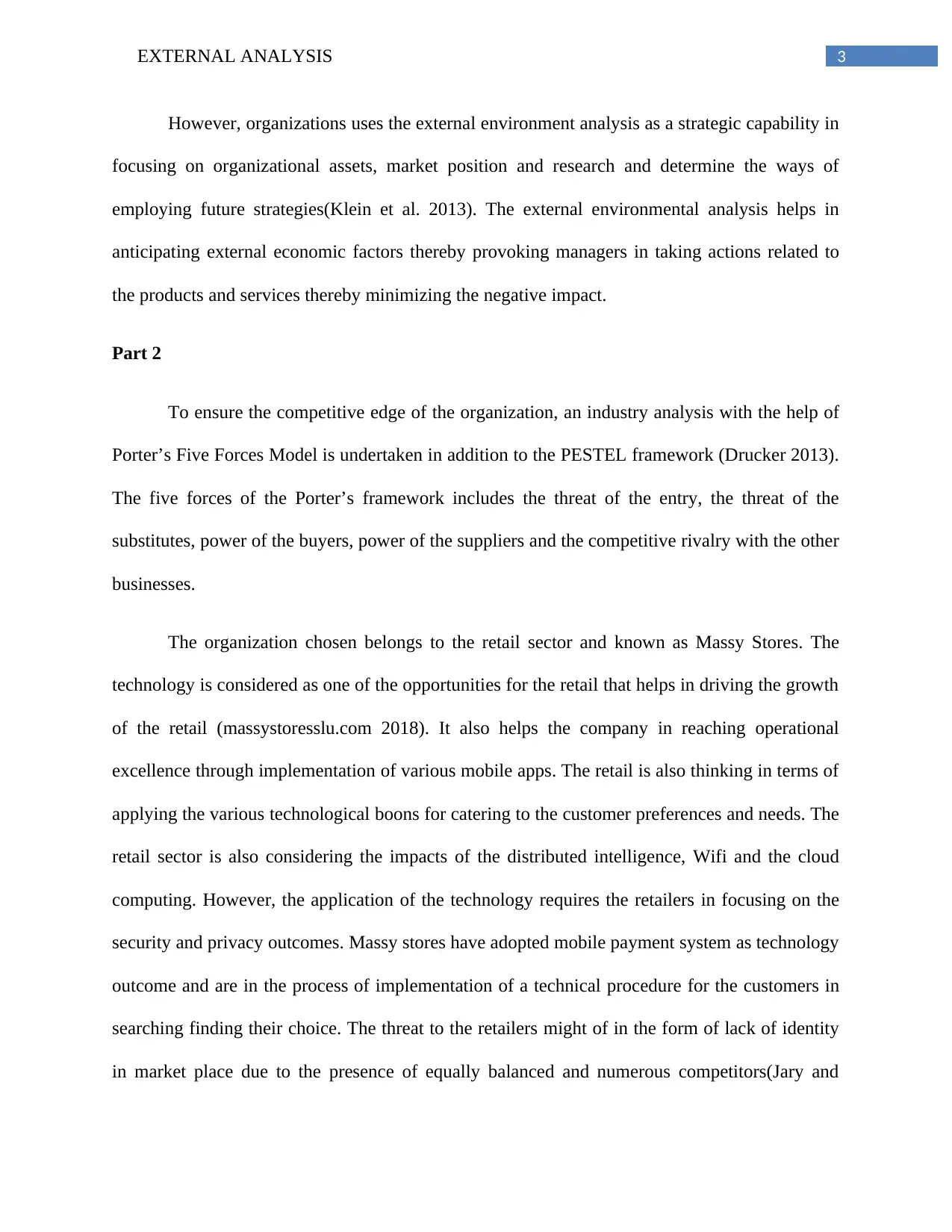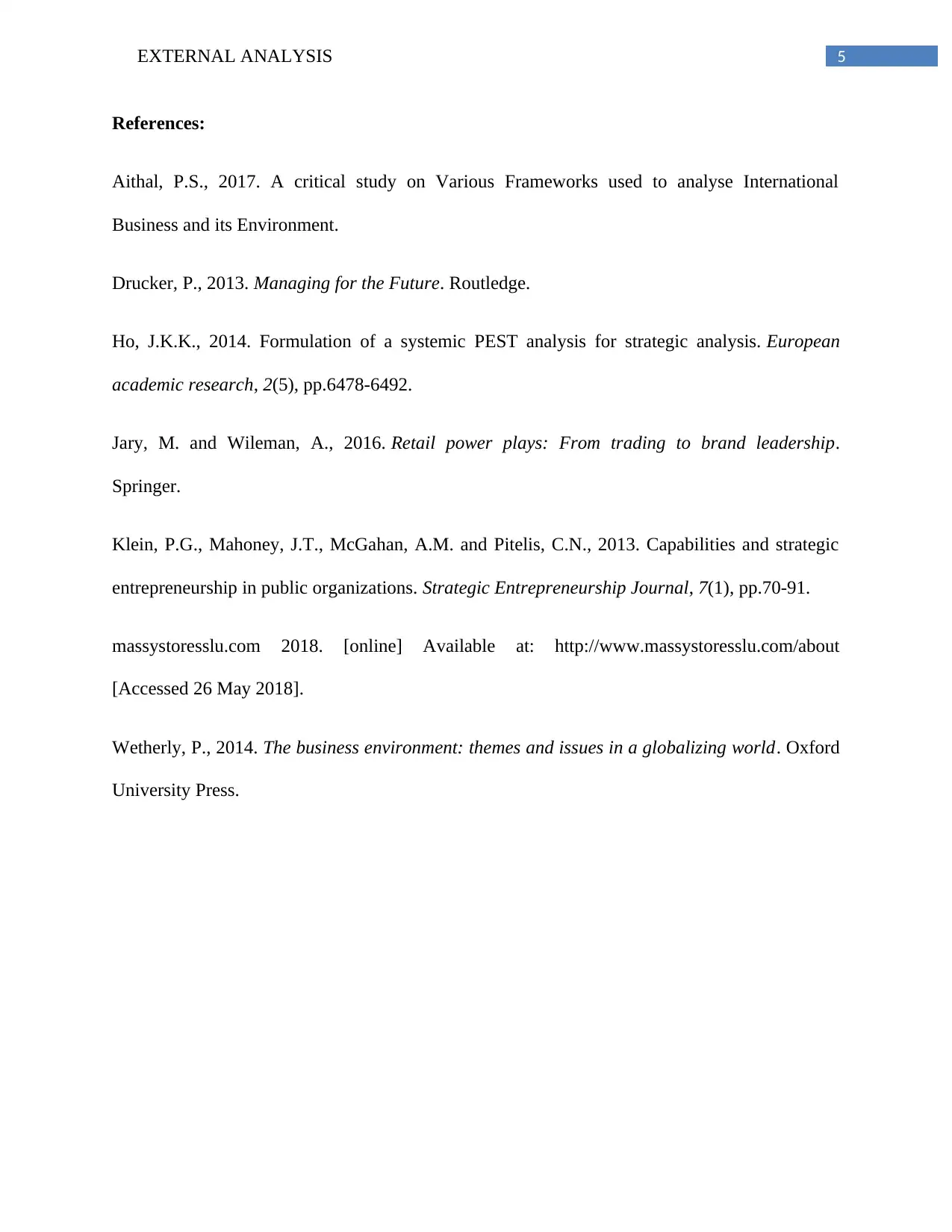In-depth External Analysis: Strategic Management Report - KMGT 710
VerifiedAdded on 2023/06/11
|6
|1133
|370
Report
AI Summary
This report provides a comprehensive external analysis using the PESTEL framework and Porter's Five Forces model to assess the macro and industry environments affecting an organization, specifically focusing on Massy Stores in the retail sector. The PESTEL analysis examines political, economic, socio-demographic, technological, ecological, and legal factors, highlighting both opportunities and threats. The Porter's Five Forces analysis evaluates the threat of new entrants, substitute products, buyer power, supplier power, and competitive rivalry. The report emphasizes the importance of aligning internal capabilities with the external context to maintain a competitive edge, particularly through leveraging technology while addressing security and privacy concerns. The analysis aims to inform strategic decision-making and proactive management in response to external economic factors.

Running head: EXTERNAL ANALYSIS
External Analysis
Name of the Student:
Name of the University:
Author Note:
External Analysis
Name of the Student:
Name of the University:
Author Note:
Paraphrase This Document
Need a fresh take? Get an instant paraphrase of this document with our AI Paraphraser

1EXTERNAL ANALYSIS
Part 1
The continuously changing competitive and complex business environment leads to
major challenges in the organization for which the managers needs to pay additional attention to
their strategic business plan. This instills the need for the adoption of the analytical tools at the
different levels that helps indentifying the factors affecting the environment, the types of the
elements influencing the competition and the means of assessing the firm’s resources. The
PESTEL framework is one of the most useful analytical tools used for analyzing the threats and
the opportunities in macro environment that helps in determining the position of the organization
or its product in the market place (Ho 2014). The acronym consists of six interrelated factors that
influence an organization. These include political, economic, socio-demographic, technological,
ecological and legal factors that generate the opportunities and the threats. Paying necessary
attention while applying the framework can provide necessary insight into external environment
and thereby help the organization in aligning the internal resources for ensuring that they meet
the market needs or the context where they operate. A rigorous application of the framework
provides significant details about factor that leads to the opportunities and threats. However,
each element of the framework is described below in detail:
Political Factors: They include the impact of state or political forces that might be vital
pieces of ideology and legislation. Most business prefers stability and hence the change of the
political context might not be desirable since they affect factors related to legislation and
expenditure of the government.
Economic Factors: They include the macro economic factors that influence
organizations. These include the interest rates, exchange rates and the positioning in business and
Part 1
The continuously changing competitive and complex business environment leads to
major challenges in the organization for which the managers needs to pay additional attention to
their strategic business plan. This instills the need for the adoption of the analytical tools at the
different levels that helps indentifying the factors affecting the environment, the types of the
elements influencing the competition and the means of assessing the firm’s resources. The
PESTEL framework is one of the most useful analytical tools used for analyzing the threats and
the opportunities in macro environment that helps in determining the position of the organization
or its product in the market place (Ho 2014). The acronym consists of six interrelated factors that
influence an organization. These include political, economic, socio-demographic, technological,
ecological and legal factors that generate the opportunities and the threats. Paying necessary
attention while applying the framework can provide necessary insight into external environment
and thereby help the organization in aligning the internal resources for ensuring that they meet
the market needs or the context where they operate. A rigorous application of the framework
provides significant details about factor that leads to the opportunities and threats. However,
each element of the framework is described below in detail:
Political Factors: They include the impact of state or political forces that might be vital
pieces of ideology and legislation. Most business prefers stability and hence the change of the
political context might not be desirable since they affect factors related to legislation and
expenditure of the government.
Economic Factors: They include the macro economic factors that influence
organizations. These include the interest rates, exchange rates and the positioning in business and

2EXTERNAL ANALYSIS
economic cycles. Then current economic recession taking place globally had significant impact
on the business in terms of spending and lending of money to other businesses.
Socio-demographic Factors: These factors include the lifestyle choices made by the
people along with the demographic structure of the countries.
Technological Factors: These include the influence of the internet or the social media on
the organization.
Ecological Factors: These refer to the green issues that help in the creation of the
opportunities and the threats. These factors include the pollution impact, carbon reduction or
recycling on the organization.
Legal Factors: This includes the regulatory or the legislative context within which an
organization work. They often related to the monopoly and the mergers regulation.
The strengths of the framework lie in the fact that it helps in identification of the key
trends, weaker signals and the inflection points that ultimately leads to the inflection points. The
inflection point refers to the moment that causes a shift in the direction of the trend. For instance,
retailing arrived at a point of inflection with the impact of the internet shopping of various
countries (Aithal 2017). The development leads to planning of the scenario in terms of different
possibilities, solutions, strategies, and impacts meant for dealing with different scenario. The
capability in planning for the scenario can act as greater strength for the organization involving
the creative mix of the analysis, innovation and storytelling. The weakness of the model lies in
only covering the external environment sometimes the results of which might not be complete
(Wetherly 2014).
economic cycles. Then current economic recession taking place globally had significant impact
on the business in terms of spending and lending of money to other businesses.
Socio-demographic Factors: These factors include the lifestyle choices made by the
people along with the demographic structure of the countries.
Technological Factors: These include the influence of the internet or the social media on
the organization.
Ecological Factors: These refer to the green issues that help in the creation of the
opportunities and the threats. These factors include the pollution impact, carbon reduction or
recycling on the organization.
Legal Factors: This includes the regulatory or the legislative context within which an
organization work. They often related to the monopoly and the mergers regulation.
The strengths of the framework lie in the fact that it helps in identification of the key
trends, weaker signals and the inflection points that ultimately leads to the inflection points. The
inflection point refers to the moment that causes a shift in the direction of the trend. For instance,
retailing arrived at a point of inflection with the impact of the internet shopping of various
countries (Aithal 2017). The development leads to planning of the scenario in terms of different
possibilities, solutions, strategies, and impacts meant for dealing with different scenario. The
capability in planning for the scenario can act as greater strength for the organization involving
the creative mix of the analysis, innovation and storytelling. The weakness of the model lies in
only covering the external environment sometimes the results of which might not be complete
(Wetherly 2014).
⊘ This is a preview!⊘
Do you want full access?
Subscribe today to unlock all pages.

Trusted by 1+ million students worldwide

3EXTERNAL ANALYSIS
However, organizations uses the external environment analysis as a strategic capability in
focusing on organizational assets, market position and research and determine the ways of
employing future strategies(Klein et al. 2013). The external environmental analysis helps in
anticipating external economic factors thereby provoking managers in taking actions related to
the products and services thereby minimizing the negative impact.
Part 2
To ensure the competitive edge of the organization, an industry analysis with the help of
Porter’s Five Forces Model is undertaken in addition to the PESTEL framework (Drucker 2013).
The five forces of the Porter’s framework includes the threat of the entry, the threat of the
substitutes, power of the buyers, power of the suppliers and the competitive rivalry with the other
businesses.
The organization chosen belongs to the retail sector and known as Massy Stores. The
technology is considered as one of the opportunities for the retail that helps in driving the growth
of the retail (massystoresslu.com 2018). It also helps the company in reaching operational
excellence through implementation of various mobile apps. The retail is also thinking in terms of
applying the various technological boons for catering to the customer preferences and needs. The
retail sector is also considering the impacts of the distributed intelligence, Wifi and the cloud
computing. However, the application of the technology requires the retailers in focusing on the
security and privacy outcomes. Massy stores have adopted mobile payment system as technology
outcome and are in the process of implementation of a technical procedure for the customers in
searching finding their choice. The threat to the retailers might of in the form of lack of identity
in market place due to the presence of equally balanced and numerous competitors(Jary and
However, organizations uses the external environment analysis as a strategic capability in
focusing on organizational assets, market position and research and determine the ways of
employing future strategies(Klein et al. 2013). The external environmental analysis helps in
anticipating external economic factors thereby provoking managers in taking actions related to
the products and services thereby minimizing the negative impact.
Part 2
To ensure the competitive edge of the organization, an industry analysis with the help of
Porter’s Five Forces Model is undertaken in addition to the PESTEL framework (Drucker 2013).
The five forces of the Porter’s framework includes the threat of the entry, the threat of the
substitutes, power of the buyers, power of the suppliers and the competitive rivalry with the other
businesses.
The organization chosen belongs to the retail sector and known as Massy Stores. The
technology is considered as one of the opportunities for the retail that helps in driving the growth
of the retail (massystoresslu.com 2018). It also helps the company in reaching operational
excellence through implementation of various mobile apps. The retail is also thinking in terms of
applying the various technological boons for catering to the customer preferences and needs. The
retail sector is also considering the impacts of the distributed intelligence, Wifi and the cloud
computing. However, the application of the technology requires the retailers in focusing on the
security and privacy outcomes. Massy stores have adopted mobile payment system as technology
outcome and are in the process of implementation of a technical procedure for the customers in
searching finding their choice. The threat to the retailers might of in the form of lack of identity
in market place due to the presence of equally balanced and numerous competitors(Jary and
Paraphrase This Document
Need a fresh take? Get an instant paraphrase of this document with our AI Paraphraser

4EXTERNAL ANALYSIS
Wileman 2016). Massy Stores have tried to overcome the threats by providing unique in service
delivery and adopting means to extend their reach constantly.
Wileman 2016). Massy Stores have tried to overcome the threats by providing unique in service
delivery and adopting means to extend their reach constantly.

5EXTERNAL ANALYSIS
References:
Aithal, P.S., 2017. A critical study on Various Frameworks used to analyse International
Business and its Environment.
Drucker, P., 2013. Managing for the Future. Routledge.
Ho, J.K.K., 2014. Formulation of a systemic PEST analysis for strategic analysis. European
academic research, 2(5), pp.6478-6492.
Jary, M. and Wileman, A., 2016. Retail power plays: From trading to brand leadership.
Springer.
Klein, P.G., Mahoney, J.T., McGahan, A.M. and Pitelis, C.N., 2013. Capabilities and strategic
entrepreneurship in public organizations. Strategic Entrepreneurship Journal, 7(1), pp.70-91.
massystoresslu.com 2018. [online] Available at: http://www.massystoresslu.com/about
[Accessed 26 May 2018].
Wetherly, P., 2014. The business environment: themes and issues in a globalizing world. Oxford
University Press.
References:
Aithal, P.S., 2017. A critical study on Various Frameworks used to analyse International
Business and its Environment.
Drucker, P., 2013. Managing for the Future. Routledge.
Ho, J.K.K., 2014. Formulation of a systemic PEST analysis for strategic analysis. European
academic research, 2(5), pp.6478-6492.
Jary, M. and Wileman, A., 2016. Retail power plays: From trading to brand leadership.
Springer.
Klein, P.G., Mahoney, J.T., McGahan, A.M. and Pitelis, C.N., 2013. Capabilities and strategic
entrepreneurship in public organizations. Strategic Entrepreneurship Journal, 7(1), pp.70-91.
massystoresslu.com 2018. [online] Available at: http://www.massystoresslu.com/about
[Accessed 26 May 2018].
Wetherly, P., 2014. The business environment: themes and issues in a globalizing world. Oxford
University Press.
⊘ This is a preview!⊘
Do you want full access?
Subscribe today to unlock all pages.

Trusted by 1+ million students worldwide
1 out of 6
Related Documents
Your All-in-One AI-Powered Toolkit for Academic Success.
+13062052269
info@desklib.com
Available 24*7 on WhatsApp / Email
![[object Object]](/_next/static/media/star-bottom.7253800d.svg)
Unlock your academic potential
Copyright © 2020–2025 A2Z Services. All Rights Reserved. Developed and managed by ZUCOL.





